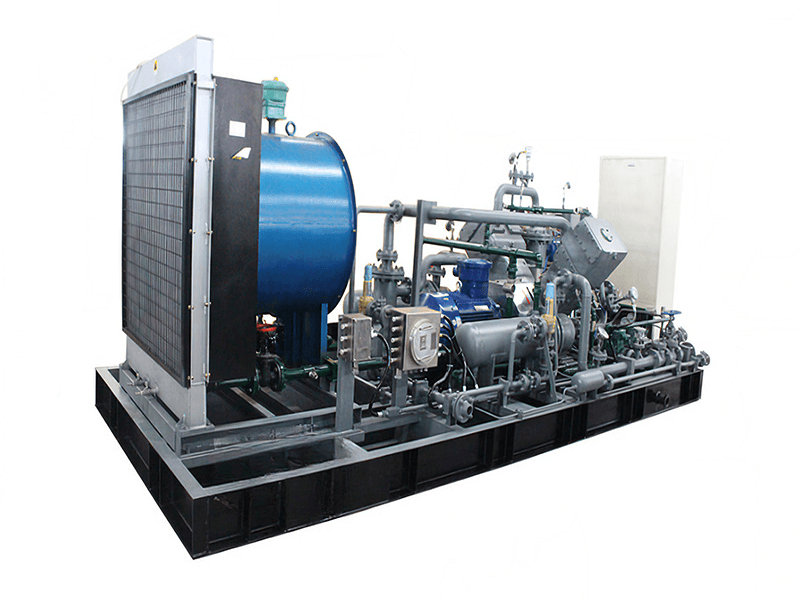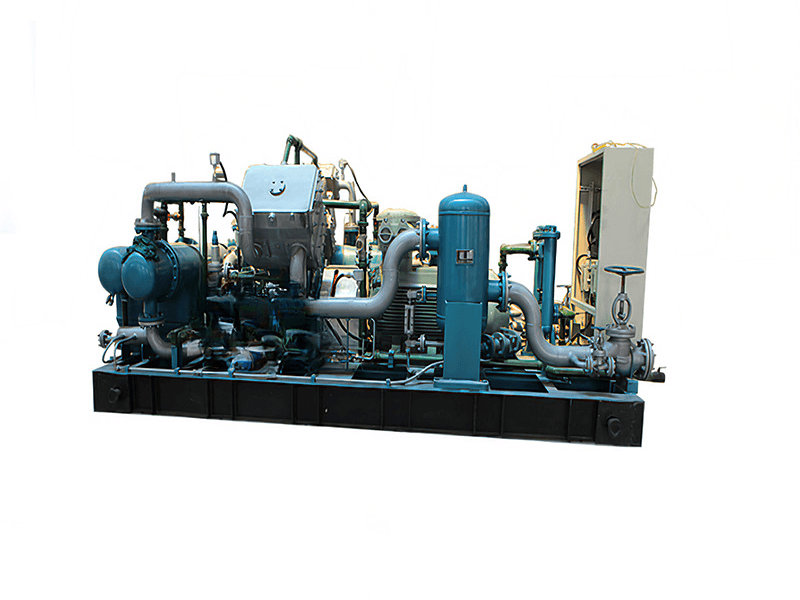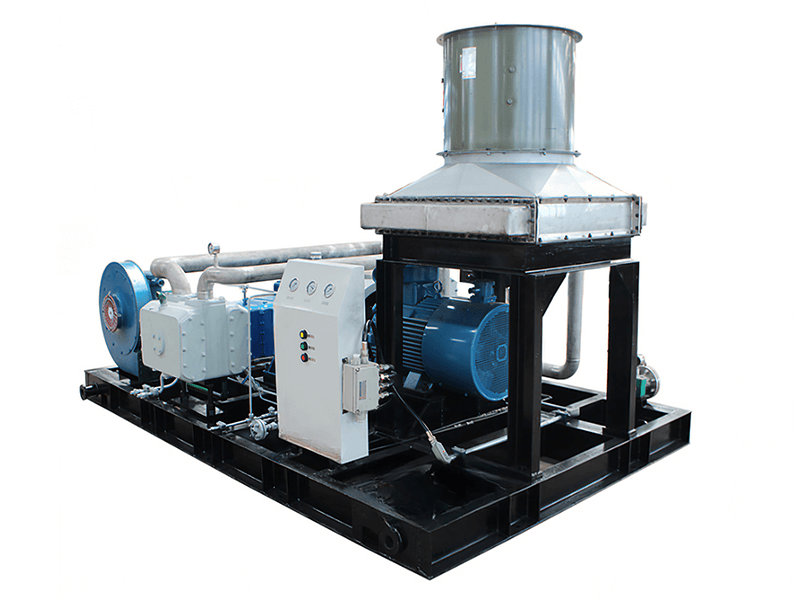With the transition of global energy structure to decarbonization, the importance of natural gas as a clean energy source is becoming more and more prominent. Long-distance pipeline is the core carrier of cross-regional transportation of natural gas, and its efficient and safe operation depends on the continuous optimization of the pressurization system. In the pressurization system, the compressor, as the core power equipment, directly affects the pipeline's delivery capacity and economy. With its high pressure ratio, high efficiency and strong adaptability to working conditions, piston compressor occupies an important position in natural gas long-distance pipeline. This paper will systematically discuss the role of piston compressor in pressurization system from the technical principle, application scenario, typical cases and future development direction.
1 The working principle and structural characteristics of piston compressor
Piston compressor is a reciprocating piston movement through the realization of gas compression of volumetric machinery. Its core structure includes cylinders, pistons, crankshaft connecting rod mechanism and valve system. The workflow is divided into three stages of inlet, compression and outlet: when the piston is moving downward, the inlet valve opens, and the low-pressure gas enters the cylinder; when the piston is moving upward, the valve closes, and the gas is compressed to the set pressure, and then the outlet valve opens, and the high-pressure gas is output.
Compared with centrifugal compressor, the advantage of piston compressor is:
1)High pressure ratio capability: the compression ratio of single stage can reach more than 3:1, and the outlet pressure can break through 20MPa after multi-stage series connection, which is suitable for the high pressure demand of long-distance pipeline.
2)Adaptability to variable working conditions: by adjusting the rotational speed or cylinder clearance volume, it can flexibly cope with the fluctuation of gas volume and adapt to the change of pipeline load.
3)High efficiency and energy saving: the adiabatic efficiency is as high as 85%~90%, especially in small flow and high pressure scenarios with significant energy consumption advantages.
However, its complex structure, high vibration and noise, maintenance costs and other issues still need to be optimized through technological innovation.
2 Application Scenarios of Piston Compressor in Natural Gas Pipeline Pressurization System
1)High-pressure natural gas trunk line pressurization
The design pressure of long-distance pipeline is usually 8~12MPa. With the prolongation of transportation distance, the gas pressure gradually decreases due to friction resistance. Piston compressors are relayed through multi-stage booster stations to restore the pressure to the design value and ensure the efficiency of gas transmission. For example, China's west-east gas pipeline uses multiple piston compressors in series, and the daily gas transmission capacity of a single station can reach 150 million cubic meters.
2)Gas field gathering and low pressure gas recovery
In the late stage of gas field development, the wellhead pressure drops, which makes traditional centrifuges unable to pressurize effectively. Piston compressor can recover low-pressure gas through multi-stage compression and improve the utilization rate of resources. For example, after the introduction of piston compressor in a gas field in Ordos Basin, the recovery rate of low-pressure gas increased by 30%.
3)Peak regulation and emergency supply protection
When gas consumption peaks in winter or when pipelines break down suddenly, piston compressors can be quickly started and stopped to realize flexible peak shifting in conjunction with gas storage reservoirs. For example, a gas storage depot in North China adopts a mobile piston compressor unit, and the emergency response time is shortened to 2 hours.

3 Typical Case Studies
Case 1: Rehabilitation of Booster Station of the Third West-East Natural Gas Transmission Line
Background:A section of the third line of West-East Natural Gas Transmission is characterized by high terrain undulation, and the efficiency of the original centrifugal compressor is insufficient during low load hours.
Solution: Add 4 sets of electrically-driven reciprocating piston compressors, with a single machine power of 5MW and a design pressure of 12MPa.
Result:Gas transmission capacity increased by 25%, annual energy saving of about 12 million kWh, and payback period shortened to 3 years.
Case 2: China-Russia East Natural Gas Pipeline (Heihe-Shanghai section)
Challenge: The pipeline crosses the extremely cold area (-40℃), and the equipment needs to have low-temperature startup and wear-resistant performance.
Technical solution:low-temperature alloy cylinder material is used, equipped with intelligent preheating system; piston ring is made of carbon fiber composite material, which extends the life by 50%.
Operation data:3 consecutive years of trouble-free operation, average annual maintenance cost reduced by 15%.
Case 3: U.S. shale gas pipeline pressurization system
Requirements: Shale gas extraction with high pressure fluctuation and high impurity content.
Design innovation:Configuration of multi-stage filtration system and adaptive gas valve, allowing direct compression of gas with liquid content up to 5%.
Benefits:Equipment availability increased to 98% and overall cost decreased by 20%.
4 Technical Challenges and Optimization Countermeasures
1) Vibration and noise control
The reciprocating motion of the piston compressor is prone to mechanical vibration, which may damage pipeline welds in long-term operation. Countermeasures include:
Optimize the crankshaft balance design and add hydraulic shock absorbers;
Adopting a modular soundproof box to reduce noise from 110dB to less than 85dB.
2) Enhancement of critical component life
Wear and tear of valves and piston rings is a major source of failure. With surface coating technology (e.g. titanium nitride) and real-time monitoring systems (e.g. acoustic emission sensors), maintenance intervals can be extended to 8,000 hours.
3)Intelligent operation and maintenance
Integrate Internet of Things (IoT) and big data analysis to achieve fault prediction and energy efficiency optimization. For example, a European pipeline company dynamically adjusts the number of compression stages through AI algorithms, reducing energy consumption by 8%.
5 Future Development Trends
1)Adaptation of hydrogen energy transportation: With the development of hydrogen energy industry, piston compressors need to adapt to the characteristics of small molecular weight of hydrogen, easy to leak, and the material sealing technology is in need of a breakthrough.
2)Low-carbon design: Promote electric drive to replace gas turbine drive, combined with photovoltaic/energy storage system to create zero-carbon booster stations.
3)Ultra-high-pressure technology: develop compressor sets with a pressure resistance of 30MPa or more to support the construction of next-generation ultra-long-distance pipelines.
Conclusion
With its high pressure ratio and high adaptability, piston compressor is irreplaceable in the pressurization system of natural gas long-distance pipeline. Typical cases show that they are effective in improving gas transmission efficiency and ensuring energy security. In the future, with the integration of intelligence and new material technology, piston compressors will continue to make breakthroughs in the fields of energy efficiency optimization and multi-energy adaptation, providing more reliable power support for the global energy transportation network.

























